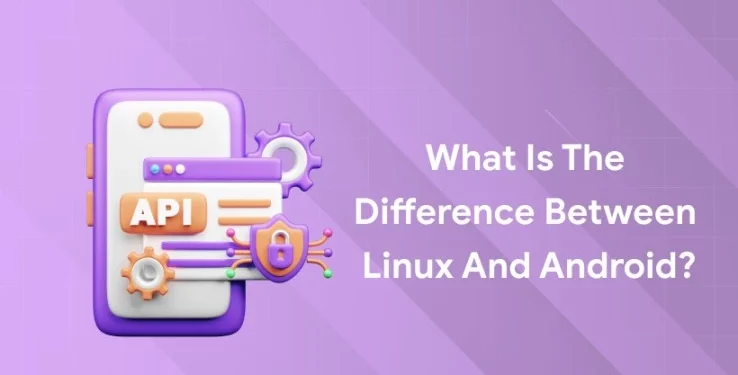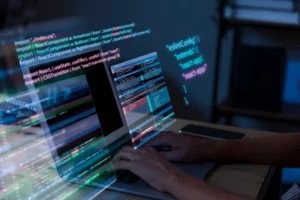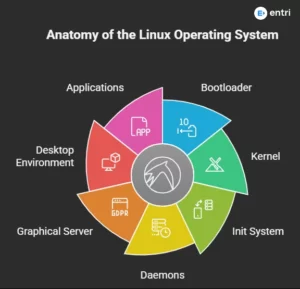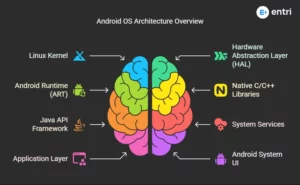Table of Contents
With operating systems releasing every now and then, keeping track of them is a big task. Especially, when mobile companies have started releasing their own operating systems. But how is it possible? Are there much differences between operating systems used in mobile phones and PCs – specifically, between Linux and Android? Let us find out!
Check out this video by Entri in Malayalam!
Introduction
Linux is a group of open-source Unix-like operating systems which was developed by Linus Torvalds. It is a package of Linux distribution. Some of the most used Linux distributions are Debian, Fedora, and Ubuntu. It was basically written in C language and assembly language. The kernel used in Linux is a Monolithic kernel. The target systems of Linux distributions are cloud computing, embedded systems, mobile devices, personal computers, servers, mainframe computers, and supercomputers. The first version of Linux was launched in 1991. The most recent version of Linux for personal computers is 5.6 (kernel).
Android is a mobile operating system that is provided by Google. It is based on the modified version of the Linux kernel and other open-source software. It is specifically designed for touchscreen mobile devices like smartphones and tablets. It was developed using C, Java, C++, and other languages. The first version of Android was launched by Google in 2008. The latest stable version of Android is Android 10. It is provided totally free of cost. It is the most used operating system overall.
From smartphones to cars, supercomputers and home appliances, home desktops to enterprise servers, the Linux operating system is everywhere.
Linux has been around since the mid-1990s and has reached a user-base that spans the globe. Linux is actually everywhere: It’s in your phones, your thermostats, in your cars, refrigerators, and televisions. It also runs most of the Internet, all of the world’s top 500 supercomputers, and the world’s stock exchanges.
But besides being the platform of choice to run desktops, servers, and embedded systems across the globe, Linux is one of the most reliable, secure and worry-free operating systems available.
Here is all the information you need to get up to speed on the Linux platform.
Thinking about developing an app? Create one with Entri’s Flutter training course!
What is Linux?
Just like Windows, iOS, and Mac OS, Linux is an operating system. In fact, one of the most popular platforms on the planet, Android, is powered by the Linux operating system. An operating system is software that manages all of the hardware resources associated with your desktop or laptop. To put it simply, the operating system manages the communication between your software and your hardware. Without the operating system (OS), the software wouldn’t function.
The Linux operating system comprises several different pieces:
-
Bootloader
The software that manages the boot process of your computer. For most users, this will simply be a splash screen that pops up and eventually goes away to boot into the operating system.
-
Kernel
This is the one piece of the whole that is actually called ‘Linux’. The kernel is the core of the system and manages the CPU, memory, and peripheral devices. The kernel is the lowest level of the OS.
-
Init system
This is a sub-system that bootstraps the user space and is charged with controlling daemons. One of the most widely used init systems is systemd, which also happens to be one of the most controversial. It is the init system that manages the boot process, once the initial booting is handed over from the bootloader (i.e., GRUB or GRand Unified Bootloader).
-
Daemons
These are background services (printing, sound, scheduling, etc.) that either start up during boot or after you log into the desktop.
-
Graphical server
This is the sub-system that displays the graphics on your monitor. It is commonly referred to as the X server or just X.
-
Desktop environment
This is the piece that the users actually interact with. There are many desktop environments to choose from (GNOME, Cinnamon, Mate, Pantheon, Enlightenment, KDE, Xfce, etc.). Each desktop environment includes built-in applications (such as file managers, configuration tools, web browsers, and games).
-
Applications
Desktop environments do not offer the full array of apps. Just like Windows and macOS, Linux offers thousands upon thousands of high-quality software titles that can be easily found and installed. Most modern Linux distributions include App Store-like tools that centralize and simplify application installation. For example, Ubuntu Linux has the Ubuntu Software Center (a rebrand of GNOME Software) which allows you to quickly search among the thousands of apps and install them from one centralized location.
Level up in app development with Entri’s Flutter course. Click to know more!
Why use Linux?
This is the one question that most people ask. Why bother learning a completely different computing environment, when the operating system that ships with most desktops, laptops, and servers works just fine?
To answer that question, I would pose another question. Does that operating system you are currently using really work “just fine”? Or, do you find yourself battling obstacles like viruses, malware, slow down, crashes, costly repairs, and licensing fees?
If you struggle with the above, Linux might be the perfect platform for you. Linux has evolved into one of the most reliable computer ecosystems on the planet. Combine that reliability with zero cost of entry and you have the perfect solution for a desktop platform.

That’s right, zero cost of entry… as in free. You can install Linux on as many computers as you like without paying a cent for software or server licensing.
Let’s take a look at the cost of a Linux server in comparison to Windows Server 2016. The price of the Windows Server 2016 Standard edition is $882.00 USD (purchased directly from Microsoft). That doesn’t include Client Access License (CALs) and licenses for other software you may need to run (such as a database, a web server, mail server, etc.). For example, a single user CAL, for Windows Server 2016, costs $38.00. If you need to add 10 users, for example, that’s $388.00 more dollars for server software licensing. With the Linux server, it’s all free and easy to install. In fact, installing a full-blown web server (that includes a database server), is just a few clicks or commands away.
If zero cost isn’t enough to win you over–what about having an operating system that will work, trouble free, for as long as you use it? Linux is generally far less vulnerable to attacks such as ransomware, malware, or viruses. As for server reboots, they are only necessary if the kernel is updated. It is not out of the ordinary for a Linux server to go years without being rebooted. If you follow the regular recommended updates, stability and dependability are practically assured.
What is Android?
Android is the best-selling Operating System among various mobile platforms across the globe. Hundreds of millions of mobile devices are powered by Android in more than 190 countries of the world. It conquered around 72.15% of the global market share as of May 2025, and this trend is growing bigger every other day.
Prerequisites: Basics of XML and Java or Kotlin programming language.
The different pieces that comprise the Android OS are:
1. Linux Kernel
-
Acts as the core of the OS.
-
Manages low-level hardware interactions (e.g., memory, process management, networking, security).
-
Includes device drivers for things like the display, camera, Bluetooth, etc.
2. Hardware Abstraction Layer (HAL)
-
Provides a standard interface for hardware vendors to implement.
-
Allows Android to be hardware-agnostic.
-
Examples: Camera HAL, Audio HAL, Bluetooth HAL, Sensors HAL.
3. Android Runtime (ART)
-
Replaces the older Dalvik VM.
-
Runs apps using Ahead-Of-Time (AOT) compilation for better performance.
-
Includes core Java libraries for app development.
4. Native C/C++ Libraries
-
Libraries used by both the system and apps.
-
Examples:
-
libc: standard C library.
-
WebKit: web rendering engine.
-
OpenGL ES: graphics rendering.
-
SQLite: lightweight relational database.
-
5. Java API Framework
-
Exposes the functionality of the Android system to app developers.
-
Built on top of native libraries and ART.
-
Key parts:
-
Activity Manager: manages app lifecycle.
-
Window Manager: manages UI windows.
-
Content Providers: manage data sharing between apps.
-
Package Manager: handles app installation and updates.
-
6. System Services
-
Run in the background to handle core Android functions.
-
Examples:
-
Location Manager: for GPS services.
-
Notification Manager: for managing notifications.
-
Telephony Manager: for phone services.
-
7. Application Layer
-
The topmost layer where user-facing apps exist.
-
Includes both system apps (like Phone, Settings, Camera) and user-installed apps.
-
Apps run in their own sandboxed process for security.
8. Android System UI
-
The system’s graphical interface components.
-
Includes:
-
Status bar
-
Navigation bar
-
Lock screen
-
Notifications
-
Why Use Android?
If you ask this question in front of an iOS user and an Android user, a debate is sure to follow that may or may not end up in a fight! (joking) The question as to why use Android is relevant in trying to understand its use cases and for whom exactly. Let us dive into that aspect. For that, we need to categorise the consumers into 3:
- When it comes to the normal user, they get to choose from a large range of devices that support the OS, and that too for prices ranging from budget to flagship. You get built-in Google integration, like Gmail, Maps, Assistant, Drive, etc. and customise the whole software according to your choices. On that note, you could sideload apps from outside the Play Store, granting you full access to your device.
- Android is a gold mine for developers. Primarily, due to the global share it holds, the reach developers can get is high in number. With the base on the Android Open Source Project (AOSP), developers have the freedom to modify the OS, build custom ROMs, or tailor apps for specific use cases. Additionally, programming languages used are familiar(Java and Kotlin) along with the existence of Android Studio to play with. Finally, Android offers access to rich APIs such as sensors, cameras, GPS, Bluetooth, NFC, machine learning, and more.
- Manufacturers and OEMs profit the most out of Android OS. Due to the free licensing from AOSP, you can freely customise for different branding or hardware. Due to the modular architecture present, they can easily roll out faster updates and maintenance Brands can produce custom UIs on their devices due to this big feature.
- Samsung – One UI
- Xiaomi – MIUI
- OnePlus – Oxygen OS
Master Android app development with Entri. Enrol now to elevate your career!
Difference between Linux and Android
The difference between Linux and Android are as follows:
| LINUX | ANDROID |
|---|---|
| It was developed by Linus Torvalds. | It was developed by Google LLC. |
| It was launched in 1991. | It was launched in 2008. |
| It is designed for PC of all companies. | It is specifically designed for mobile devices. |
| Kernel used in Linux is Monolithic. | Its Kernel type is Linux-based. |
| It has the preferred license of GNU GPLv2 (kernel). | It has the preferred license of Apache 2.0 and GNU GPLv2. |
| It is written mainly using C and assembly language. | It is written using C, C++, Java and other languages. |
| It is used in personal computers with complex tasks. | It is the most used operating system overall. |
| Its target system types are embedded systems, mobile devices, personal computers, servers, mainframe computers and supercomputers. | Its target system types are smartphones and tablet computers. |
| It is mostly used for hacking purpose-based, tasks. | It is used in mobile devices for all simple tasks. |
| Linux holds a smaller footprint compared to android. | Android holds a large footprint comparative Linux. |
| It is a derived version of Unix. | It is executed on virtual machines. |
| Linux distros use GNU C. | Android uses its own C library, Bionic. |
| Linux supports multiple architectures. | Android only supports only two major architectures: x86 and ARM. |
Become an Android App Developer with Entri’s Flutter training course! Join Now!
Conclusion: Linux and Android
To sum up, while both Linux and Android have Linux Kernel at their core, they differ in their design, usage, and purpose. Linux serves as a versatile, open-source OS suitable for a wide variety of systems and hardware offering features like robust security, customization, and a variety of user interfaces. Android, on the other hand, is a mobile centric OS focusing on user-friendly UIs and Google integration.
Understanding these differences would help users, developers, and manufacturers to get the most out of both these operating systems. If you feel like Android is the winner here and want to learn more about web and app development, check out Entri’s Flutter training course. With expert mentors and practical applications, you can master app development within a limited time. Enrol now and immerse yourself into the world of app development!
|
Related articles |
|
| What Is An SDK in Android? (With Definition,Types And Benefits) | |
Frequently Asked Questions
Is Android based on Linux?
Yes. Android is built on top of the Linux kernel, but it includes additional components tailored for mobile devices, such as the Android Runtime (ART), Java APIs, and a specialized user interface.
Can I run Linux apps on Android?
Not directly. Android does not use the standard GNU libraries found in traditional Linux distributions, so native Linux apps often won’t run unless modified or run in a Linux environment app or terminal emulator.
Can I install Android on a PC like Linux?
While Android is designed for mobile devices, versions like Android-x86 and Bliss OS allow Android to run on PCs. However, it may not offer the full desktop experience like traditional Linux distributions.
Which is more secure: Linux or Android?
Linux is generally considered more secure due to its controlled package management and user access model. Android’s security depends on device manufacturers, update frequency, and app sources.
Why is Android not considered a full Linux distribution?
Although it uses the Linux kernel, Android lacks key components like the GNU C Library (glibc), a standard desktop UI, and traditional package managers, which are typical in Linux distros.
Can I replace Android with Linux on my phone?
It’s possible on some devices with open bootloaders, but it requires technical skill and comes with risks like voiding warranties or bricking the device. Projects like PostmarketOS aim to bring Linux to mobile hardware.
What is the main difference between Linux and Android?
Linux is a general-purpose OS used in desktops, servers, and more, while Android is a mobile OS optimized for touchscreen devices and apps, heavily integrated with Google services.














